New figures from a US survey by Pew Internet Project reveal that cables are becoming, like, soooo 1990s as more and more people connect to the internet via wireless connections.
 The study, released yesterday, shows that some 34% of internet users have surfed the web or checked email on a computer or smartphone/PDA using a Wi-Fi connection or mobile phone network.
The study, released yesterday, shows that some 34% of internet users have surfed the web or checked email on a computer or smartphone/PDA using a Wi-Fi connection or mobile phone network.
Wi-Fi In The House
Wi-Fi is also proving a hit in the home, with nearly 20 percent of US Internet users now having domestic wireless networks – up a hefty 100% from the same time two years ago.
“We know that ‘always on’ broadband connections really deepen people’s relationship to the Internet; adding ‘on the go’ to the mix takes this a step further,” commented John Horrigan, associate research director at Pew.
“The convenience of wireless access gives people the chance to fire off a quick e-mail to someone while waiting in a doctor’s office or check the news headlines on the way to work,” he added.
The figures show that wireless folks are more addicted to email than other web users, with 72% checking their email ‘on a typical day’ compared to 63% of home broadband users and 54% of all internet users.
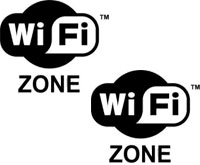 They’re news junkies too, with nearly half (46%) going online to read news compared to 38% of home broadband users and 31% of all internet users.
They’re news junkies too, with nearly half (46%) going online to read news compared to 38% of home broadband users and 31% of all internet users.
Of course, these figures should be taken with a Table Mountain of salt, because it’s ruddy obvious that someone who relies on mobile email for work is going to be using wireless connections more often than your average home user.
Where they connect
The report looked at where people hook up wirelessly and found that the majority (27%) log on in web cafes or other non- work/home environments.
Some 20% of internet users said that they’ve gone online wirelessly at home with 17% connecting at work. Naturally, there’s a fair bit of overlap, with people connecting at two or three of the places above.
It’s a shame the survey didn’t ask how many were hooking up to free networks and how many were grabbing a sneaky piggyback ride on other folks’ unprotected connections, though.
But there’s lots more analysis of varying interest here: Pew Internet (PDF)
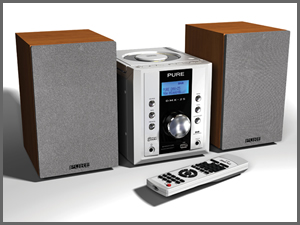 The new PURE DMX-25 DAB Micro System with MP3 playback comes with the ability to playback MP3/ WMA files from portable USB flash memory drives, SD memory cards and CDs. Beyond those terribly modern means, there’s also two auxiliary inputs, letting you connect iPod, MiniDisc or MP3 player.
The new PURE DMX-25 DAB Micro System with MP3 playback comes with the ability to playback MP3/ WMA files from portable USB flash memory drives, SD memory cards and CDs. Beyond those terribly modern means, there’s also two auxiliary inputs, letting you connect iPod, MiniDisc or MP3 player. Speakers: 4 Ohms (nominal) impedance. 10W RMS power handling. Two-way design. Treated paper mid-bass driver. Custom-tuned crossover. Rosewood finish. Removable grilles.
Speakers: 4 Ohms (nominal) impedance. 10W RMS power handling. Two-way design. Treated paper mid-bass driver. Custom-tuned crossover. Rosewood finish. Removable grilles.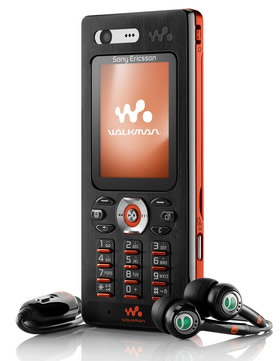 USB rules the roost for people loading and unloading content on and off their mobiles phones. It was employed in more handsets than all other interface standards combined in 2006, according to iSuppli Corp.
USB rules the roost for people loading and unloading content on and off their mobiles phones. It was employed in more handsets than all other interface standards combined in 2006, according to iSuppli Corp.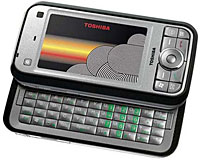 A cavalcade of new phones are continuing to spew forth from the 3GSM World Congress bash in Barcelona, and one that has especially warmed our toilet seats of desire is the ‘G900’ smartphone from Toshiba.
A cavalcade of new phones are continuing to spew forth from the 3GSM World Congress bash in Barcelona, and one that has especially warmed our toilet seats of desire is the ‘G900’ smartphone from Toshiba.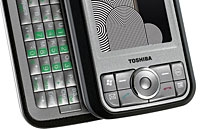 To ensure that the vast display is topped up with fast and fresh web pages there’s ultra-nippy HSDPA connectivity onboard (take that, iPhone!), with 64MB of internal memory and a miniSD card taking care of storage duties.
To ensure that the vast display is topped up with fast and fresh web pages there’s ultra-nippy HSDPA connectivity onboard (take that, iPhone!), with 64MB of internal memory and a miniSD card taking care of storage duties. Extra security comes in the form of a rear biometric scanner, and there’s also Bluetooth with A2DP support, Wi-Fi, USB On-The-Go and Microsoft’s new Windows Mobile 6 OS.
Extra security comes in the form of a rear biometric scanner, and there’s also Bluetooth with A2DP support, Wi-Fi, USB On-The-Go and Microsoft’s new Windows Mobile 6 OS.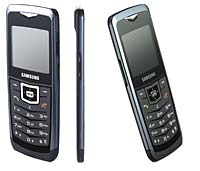 There may be controversy on the catwalks, but thin remains in with the design bods at Samsung, who have just unleashed a trio of anorexic handsets in their Ultra range, the U300, U600, U700 and ultra-thin U100.
There may be controversy on the catwalks, but thin remains in with the design bods at Samsung, who have just unleashed a trio of anorexic handsets in their Ultra range, the U300, U600, U700 and ultra-thin U100.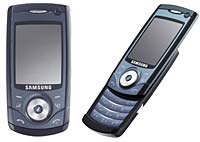 Back to the real world, there’s no denying that the U100 is an impressive piece of engineering – and purdy as a picture too – packing in a 3 mega-pixel camera, a 1.93″ color TFT screen and 11 hours of music play time into its 5.9mm wide frame.
Back to the real world, there’s no denying that the U100 is an impressive piece of engineering – and purdy as a picture too – packing in a 3 mega-pixel camera, a 1.93″ color TFT screen and 11 hours of music play time into its 5.9mm wide frame.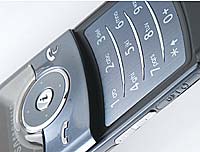 Adjusting the BS output to ‘stun,’ the press announcement tells us that the handset apparently exudes “elegance and modern style… for the ultimate sophistication” and comes in a suitably daftly-named set of colours, including sapphire blue, garnet red, platinum metal and copper gold casing.
Adjusting the BS output to ‘stun,’ the press announcement tells us that the handset apparently exudes “elegance and modern style… for the ultimate sophistication” and comes in a suitably daftly-named set of colours, including sapphire blue, garnet red, platinum metal and copper gold casing. Wrapping up the new line-up is the U300, a 9.6-mm clamshell with a 3-megapixel camera, Bluetooth, TV-out capability and 70MB of onboard storage (but no MicroSD slot).
Wrapping up the new line-up is the U300, a 9.6-mm clamshell with a 3-megapixel camera, Bluetooth, TV-out capability and 70MB of onboard storage (but no MicroSD slot).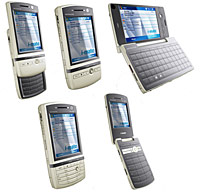 In an advanced Hedge-Betting exercise, i-mate has announced its new range of Windows Mobile devices, with a set of designs mirroring just about every handset currently available on the market.
In an advanced Hedge-Betting exercise, i-mate has announced its new range of Windows Mobile devices, with a set of designs mirroring just about every handset currently available on the market.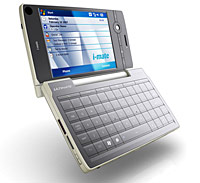 Christened the “Ultimate” range, the WM6-powered devices – all five of ’em – are numbered 5150, 6150, 7150, 9150, and 8150 (clockwise from the upper left in the compilation photo) – if you’re bored, you can play “spot the inspiration” and see if you match i-mate’s new offerings to current designs by other manufacturers.
Christened the “Ultimate” range, the WM6-powered devices – all five of ’em – are numbered 5150, 6150, 7150, 9150, and 8150 (clockwise from the upper left in the compilation photo) – if you’re bored, you can play “spot the inspiration” and see if you match i-mate’s new offerings to current designs by other manufacturers. Full details of the whole range are still dribbling through, but we’ve learnt that the Ultimate 5150 slider comes with an Intel Bulverde 520MHz CPU, VGA screen, 256MB ROM and 128MB RAM, Wi-Fi, microSD memory card slot and a 2.0 megapixel camera.
Full details of the whole range are still dribbling through, but we’ve learnt that the Ultimate 5150 slider comes with an Intel Bulverde 520MHz CPU, VGA screen, 256MB ROM and 128MB RAM, Wi-Fi, microSD memory card slot and a 2.0 megapixel camera.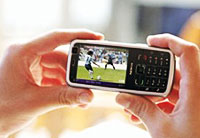 Nordic big-knobs Nokia have knocked out another two handsets for your delectation today.
Nordic big-knobs Nokia have knocked out another two handsets for your delectation today.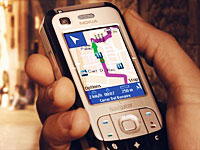 Lurking on the back is a 2 megapixel camera, with the N77 delivering on the multimedia front, offering visual radio and support for MP3, AAC, AAC+, eAAC+ and WMA media.
Lurking on the back is a 2 megapixel camera, with the N77 delivering on the multimedia front, offering visual radio and support for MP3, AAC, AAC+, eAAC+ and WMA media.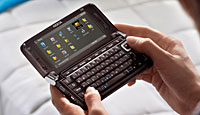 Nokia E90 Communicator
Nokia E90 Communicator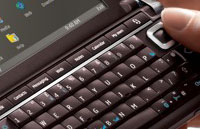 There’s also integrated GPS and Nokia Maps wedged into the chunky handset, but all those features are going to come at a wallet-whipping price, with the E90 expected to be priced at around a stratospheric €750.
There’s also integrated GPS and Nokia Maps wedged into the chunky handset, but all those features are going to come at a wallet-whipping price, with the E90 expected to be priced at around a stratospheric €750.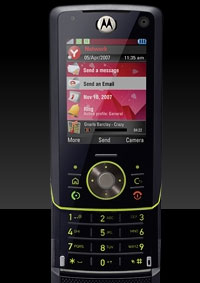 We reckon there could be moist spots breaking out in the gussets of mobile phone freaks everywhere with a veritable onslaught of new phones being announced today.
We reckon there could be moist spots breaking out in the gussets of mobile phone freaks everywhere with a veritable onslaught of new phones being announced today.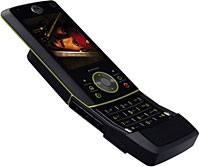 Decked out in a natty black body with green trim, the MOTORIZR Z8 features a 1.4 x 2-inch, QVGA 16 million colour display and a twin camera set up, with a 2 megapixel camera on the back (with 8x zoom and lumi LED light) and a lower spec’d VGA jobbie up front for video calls.
Decked out in a natty black body with green trim, the MOTORIZR Z8 features a 1.4 x 2-inch, QVGA 16 million colour display and a twin camera set up, with a 2 megapixel camera on the back (with 8x zoom and lumi LED light) and a lower spec’d VGA jobbie up front for video calls.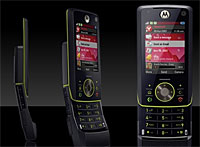 There’s also A2DP stereo Bluetooth audio onboard, support for SMS, EMS, MMS 1.22 messaging and SMTP, POP3, IMAP4, SSL/TLS2 email.
There’s also A2DP stereo Bluetooth audio onboard, support for SMS, EMS, MMS 1.22 messaging and SMTP, POP3, IMAP4, SSL/TLS2 email.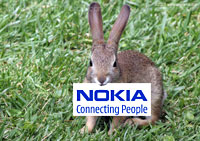 Nokia, the undisputed heavyweight champs of the mobile phone world, have taken the wraps off their new 6110 Navigator smartphone.
Nokia, the undisputed heavyweight champs of the mobile phone world, have taken the wraps off their new 6110 Navigator smartphone. According to Nokia, they will be offering the smart2go on Nokia S60 and Windows Mobile 5.0 devices, and then rolling out support for most of the major mobile OS platforms including Nokia S60/S40, PocketPC, Linux and other Windows Mobile devices.
According to Nokia, they will be offering the smart2go on Nokia S60 and Windows Mobile 5.0 devices, and then rolling out support for most of the major mobile OS platforms including Nokia S60/S40, PocketPC, Linux and other Windows Mobile devices.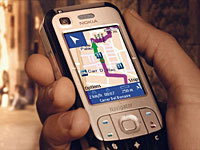 UPDATE: Image through now …. der dah!
UPDATE: Image through now …. der dah!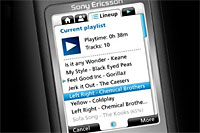 You may not have heard of them yet, but feisty Brit mobile music company Omnifone have announced one of the first big challengers to Apple’s soon-come iPhone/iTunes Store service.
You may not have heard of them yet, but feisty Brit mobile music company Omnifone have announced one of the first big challengers to Apple’s soon-come iPhone/iTunes Store service.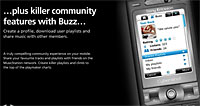 “We will ensure the vast majority of Europeans have the freedom to choose MusicStation by the time iPhone arrives in Europe. We will give consumers the choice they deserve,” he added.
“We will ensure the vast majority of Europeans have the freedom to choose MusicStation by the time iPhone arrives in Europe. We will give consumers the choice they deserve,” he added.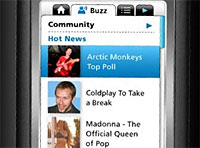 Predictably, music tracks will come with digital rights management and be delivered in the eAAC+ format (that’s enhanced advanced audio coding, in case you’re into knowing that kind of thing).
Predictably, music tracks will come with digital rights management and be delivered in the eAAC+ format (that’s enhanced advanced audio coding, in case you’re into knowing that kind of thing).